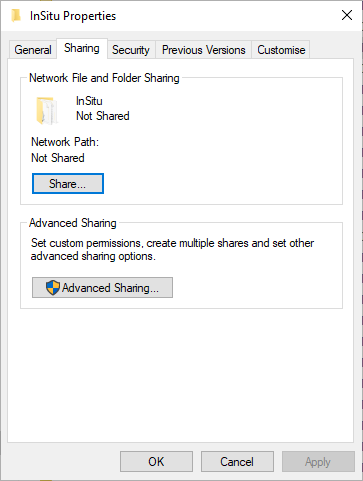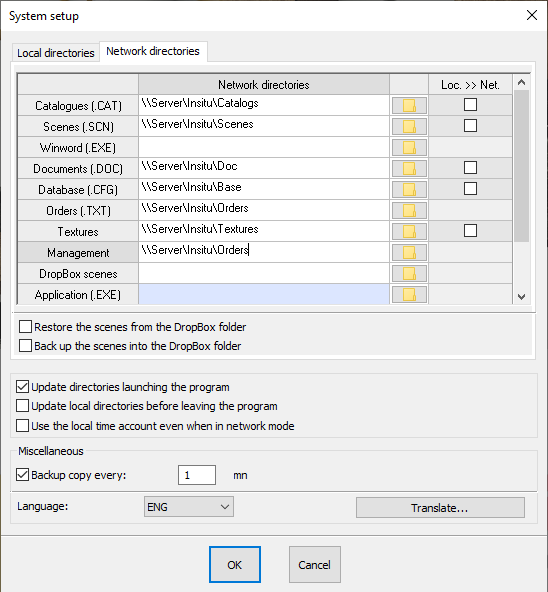Set up Insitu connected to the network: Difference between revisions
No edit summary Tag: Reverted |
No edit summary Tag: Reverted |
||
| Line 42: | Line 42: | ||
''<big>Step 2: Setting up InSitu on the server computer</big>''' | '''<big>Step 2: Setting up InSitu on the server computer</big>''' | ||
Launch InSitu on the server and then go to the <b>System set up | Network</b>. There's nothing to change here, by default the software will copy the paths that you entered at the installation stage. | Launch InSitu on the server and then go to the <b>System set up | Network</b>. There's nothing to change here, by default the software will copy the paths that you entered at the installation stage. | ||
| Line 49: | Line 49: | ||
''<big>Step 3: setting up InSitu on the client computer</big>''' | '''<big>Step 3: setting up InSitu on the client computer</big>''' | ||
Start up InSitu on the client computer and go to the | Start up InSitu on the client computer and go to the '''System set up | Network''' menu. | ||
Go to the | Go to the '''Local directories''' tab. | ||
The InSitu date directories correspond to the directories chosen during the installation or updates. | The InSitu date directories correspond to the directories chosen during the installation or updates. | ||
| Line 65: | Line 65: | ||
Now, go to the | Now, go to the '''Network directories''' tab and fill in the parameters of the network that will allow you to '''[[Synchroniser les données InSitu|synchronise]]''' (*) the client computer with the server that's home to InSitu. | ||
The information entered in the figure below is an example that is designed to help guide you. Make sure to enter your own parameters. In our example, the name of the server is | The information entered in the figure below is an example that is designed to help guide you. Make sure to enter your own parameters. In our example, the name of the server is '''server'''. | ||
<div align="center"> | <div align="center"> | ||
| Line 76: | Line 76: | ||
''(*) Synchronise''' : to update the information from the server to the client computer and from the client computer to the server. [[Synchroniser les données InSitu|Find out more]] | '''(*) Synchronise''' : to update the information from the server to the client computer and from the client computer to the server. [[Synchroniser les données InSitu|Find out more]] | ||
<!-- fin contenu --> | <!-- fin contenu --> | ||
| Line 89: | Line 89: | ||
</tr> | </tr> | ||
</table> | </table> | ||
Revision as of 10:30, 8 March 2023
|
Step 1: sharing the InSitu folder from the server computer Before connecting the InSitu software to a network, you must share the InSitu folder that is on the server with all the client computers Access the server's hard drive and search for the InSitu folder (by default, it will be installed on c:\). Right click the folder to make the shortcut menu appear. Choose the menu Properties. A window with four tabs will appear (General/Sharing/Security/Customise). Select the Sharing tab.
Click on the Advanced sharing button. The window below shall appear. Tick the Share this folder box and then, while staying in the same window, click on the Permissions button.
Next, select the Security tab and tick the Allow for Full control.
Click onApply then Close and step 1 of connecting InSitu to a network will be complete.
Launch InSitu on the server and then go to the System set up | Network. There's nothing to change here, by default the software will copy the paths that you entered at the installation stage. Be aware that it is not necessary to install InSitu on the server if you only plan on using it as a storage base (with a NAS server for example).
Start up InSitu on the client computer and go to the System set up | Network menu. Go to the Local directories tab. The InSitu date directories correspond to the directories chosen during the installation or updates. For Winword (.EXE), the path to the Word program may be different depending on the installations and the versions of Word.
The information entered in the figure below is an example that is designed to help guide you. Make sure to enter your own parameters. In our example, the name of the server is server.
(*) Synchronise : to update the information from the server to the client computer and from the client computer to the server. Find out more
|
|






